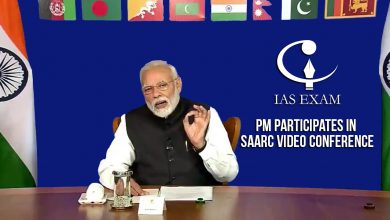THE MISSING PIECE IN INDIA’S DEFENCE JIGSAW PUZZLE
The country needs a clearly articulated white paper on its defence needs which sets out its strategic concerns
According to 2018 data, India occupies the fourth place in military expenditure across the world, behind the U.S., China, and Saudi Arabia. This does not mean that India has no further need to increase its stock of state-of-the art weapons. What is needed, nevertheless, is sober reflection and a cost-benefit analysis, to ensure that the amounts expended are in tune with our strategic requirements. We are living through a moment of decisive change and turbulence. This geopolitical period is perhaps the most troubled since the final decades of the 20th century. Hence, there exists a vital need to adopt right strategic choices.
Status of Defence Deals
- The first lot of Rafale fighter jets is expected shortly. The final deal on the 200 Kamov Ka-226 light utility helicopters from Russia is in advanced stages and expected to be signed soon. In October 2018, India and Russia had signed a $5.4-billion mega deal for the S-400 Triumf Air Defence System.
- Under contemplation today are yet another set of high-value U.S. defence deals, including additional purchases of P-8I Maritime Reconnaissance Aircraft and Apache Attack Helicopters.
- According to estimates, the total worth of defence equipment purchased from the U.S. alone since 2007 is in the region of $17-billion.
- On the eve of U.S President Donald Trump’s visit to India, a further spurt in defence purchases is anticipated. Speculation is rife that India and the U.S. would sign a deal for the National Advanced Surface to Air Missile System (NASAMS-II), intended as part of a multi-layered missile shield to protect Delhi.
Given India’s rising global profile, and with two major adversaries on its borders, India needs to be fully prepared. What is lacking in the defence jigsaw puzzle, however, is a well considered and clearly articulated white paper on India’s defence needs that sets out its strategic concerns, how it is positioning itself to meet these challenges, and the putative costs of meeting the country’s defence needs.
Threats Posed by the Neighbors
Several nations undertake defence and military exercises nowadays. In India, exercises of this kind are sometimes undertaken, but they suffer from a lack of clarity and are restricted in scope. They contain vague references to the threat posed by China and Pakistan, but there is clearly more to India’s defence needs than exercises in military hagiography. What is required is a well formulated defence white paper, putting the different threats and dangers the nation faces in perspective, alongside steps taken to meet these challenges.
- In the case of Pakistan, the threat motif is, no doubt, obvious. India’s political and defence establishment are on record that India can easily defeat Pakistan, even if a “weaker” Pakistan possesses “nuclear teeth”. Yet, while this makes for excellent copy, a great deal of effort is called for to explain to the public, the true nature of the threat posed by Pakistan, and why India is so confident of beating back the Pakistani challenge.
- Meeting the military, strategic and economic challenge from China is an entirely different matter. China is not Pakistan, and while China and Pakistan may have established an axis to keep India in check, explaining the nature of the threat posed by China to India is a complex task that needs to be undertaken with care and caution.
The Chinese Conundrum
- Undoubtedly under China’s President Xi Jinping, China aims to be a great power and an assertive one at that. India’s defence planners should, however, carefully assess whether there are degrees of “assertiveness” in China’s behavioral patterns. There is little doubt that regarding its claim to areas falling within the ‘nine-dash lines’ (the first island chain), China is unwilling to make compromises.
- It would be premature for India without undertaking such an analysis, to adhere to a common perception that China is intent on enforcing a Sino-centric world order in which India and other countries would necessarily have to play a secondary role.
- If after undertaking such an “analysis”, it appears that China does not pose a direct threat to India’s existence, notwithstanding the fact that India is its main rival in Asia, then India’s political, strategic and military planners need to come up with a different set of alternatives. In recent years, unfortunately, much of India’s strategic thinking regarding China’s aggressive behaviour has been colored by that of the U.S. and the West, though it is a proven fact that China has not used lethal military force abroad since the 1980s.
- China’s Belt and Road Initiative (BRI) does convey an impression that China seeks to put itself at the centre of the world. The speed, with which many of the steps to progress the BRI are being taken, again conveys an impression that China is intent on shrinking the physical and psychological distance between Europe and East Asia. This does not, however, necessarily mean that China is preparing to confront individual countries in Asia, such as India, which do not subscribe to the BRI.
Focus on Domestic Policies
Today, one of India’s major concerns is that China is attempting to intrude into its sphere of influence in South Asia, and the first and second concentric circles of India’s interest areas, such as Afghanistan and parts of West Asia. The defence white paper might well provide a strategic paradigm, in which India and China agree to peacefully co-exist in many areas, leaving aside conflict zones of critical importance to either, thus ensuring a more durable peace between them.
The defence white paper needs to underscore that a country’s domestic politics are an important pointer to a stable foreign policy. There could be different schools of thoughts within a nation, but equilibrium needs to be maintained if it is not to adversely impact a nation’s foreign policy imperatives. An impression that the country is facing internal strains could encourage an adversary, to exploit our weaknesses. This is a critical point that the defence white paper needs to lay stress on.SOURCE:The Hindu





.png)



